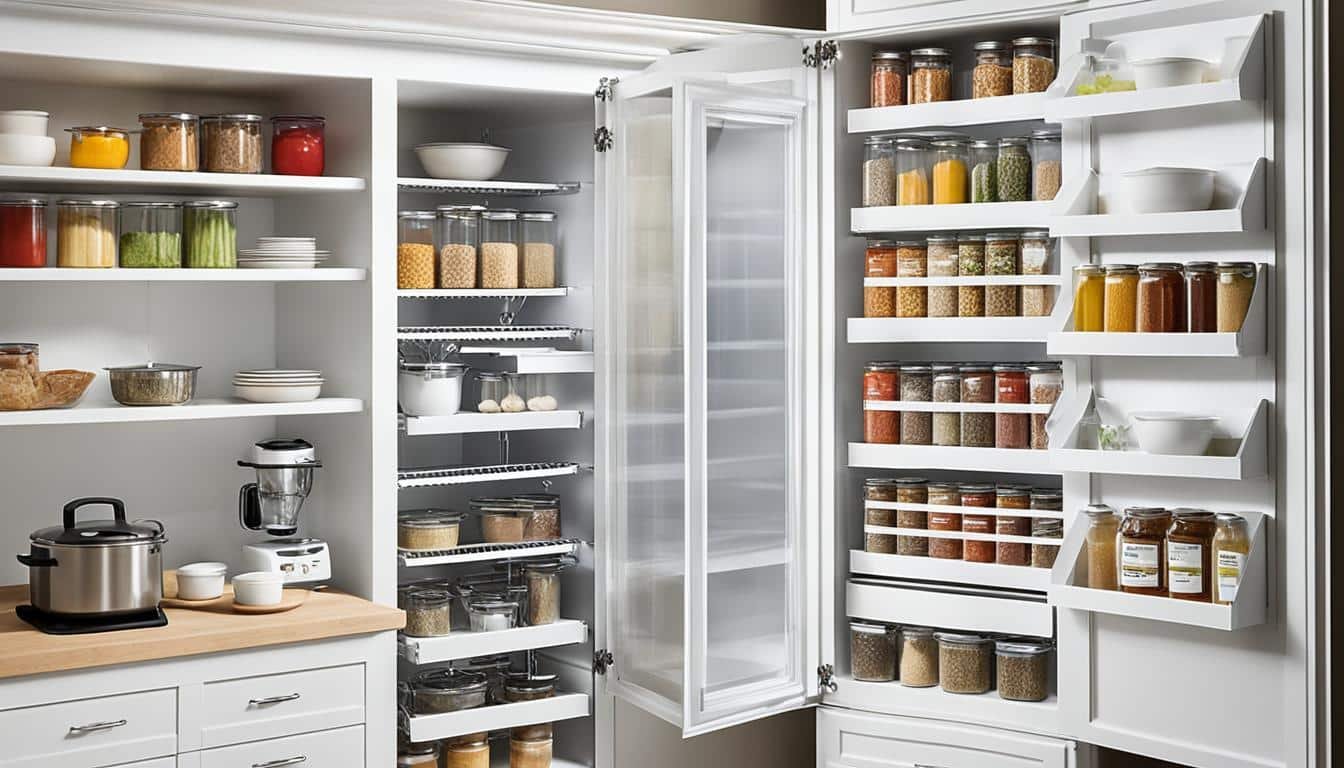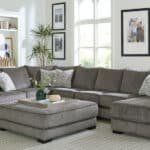Proper ventilation is key for keeping your kitchen pantry fresh and safe. Without it, problems like moisture, mold growth, and bad smells occur. These issues can ruin the quality of your foods that don’t go bad quickly. By adding vents, you help keep your pantry cool, dry, and mold-free. This makes your pantry items last longer.
Ventilation is crucial, especially in warm, damp places. In these areas, the risks of moisture, mold, and bad odors are higher.
Key Takeaways
- Proper ventilation is crucial for maintaining the freshness and safety of items stored in a kitchen pantry.
- Inadequate ventilation can lead to moisture buildup, mold growth, and the development of offensive odors.
- Ventilation regulates temperature, protects against moisture, and prevents mold, making it an essential consideration for any well-designed pantry.
- Addressing ventilation needs is especially important in hot, humid climates to prevent these issues.
- Ensuring proper ventilation can extend the lifespan of pantry items and create a well-functioning, organized storage space.
Ventilation: A Crucial Element for Pantries
For centuries, pantries have been used to store food and other items. They were mainly for bread and baked goods. Proper ventilation is key to prevent mold, pests, and moisture issues in pantries.
Consequences of Insufficient Ventilation
Good ventilation in a pantry keeps the air fresh and the temperature stable. It prevents food from spoiling quickly and cans from rusting. It also stops mold growth, making your pantry safe and organized. Proper ventilation allows you to better maintain your stored food.
Benefits of Proper Ventilation
Proper ventilation is essential in a pantry to avoid mold and pest problems. It also helps keep the pantry dry, protecting your items. Using airtight containers made of glass or plastic further guards against damage and helps food last longer.
Types of Ventilation for Pantries
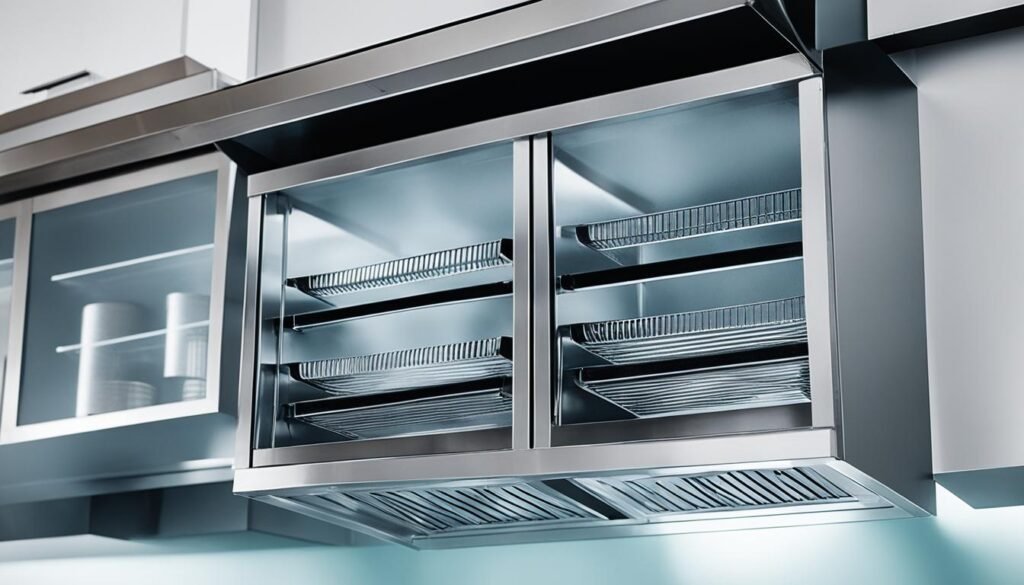
There are two main ways to keep a kitchen pantry aired out and working well. Homeowners can use passive ventilation or active ventilation. Knowing the difference helps make sure your pantry is set up right for your storage needs.
Passive Ventilation
Passive ventilation uses natural ways for air to move around. It works with the pressure changes inside and outside your pantry. This method is good for saving money and being friendly to the environment. It works well for small or big pantries that have windows or other ways for fresh air to come in.
Active Ventilation
Active ventilation needs machines to move the air, like fans and ducts. It’s good when you need to keep a closer eye on the pantry’s air and temperature. Big, enclosed pantries or ones without good ventilation from the outside can benefit from this. Machines are set up to work with the design of your pantry, making sure air moves well.
Temperature Control Systems
In some cases, pantries have extra systems to control the temperature. These work with the ventilation to keep the pantry just right. They’re helpful for storing things that don’t go bad quickly. You can use these with either passive or active ventilation. The choice depends on your pantry’s features and how you use it.
Maintaining the Right Temperature
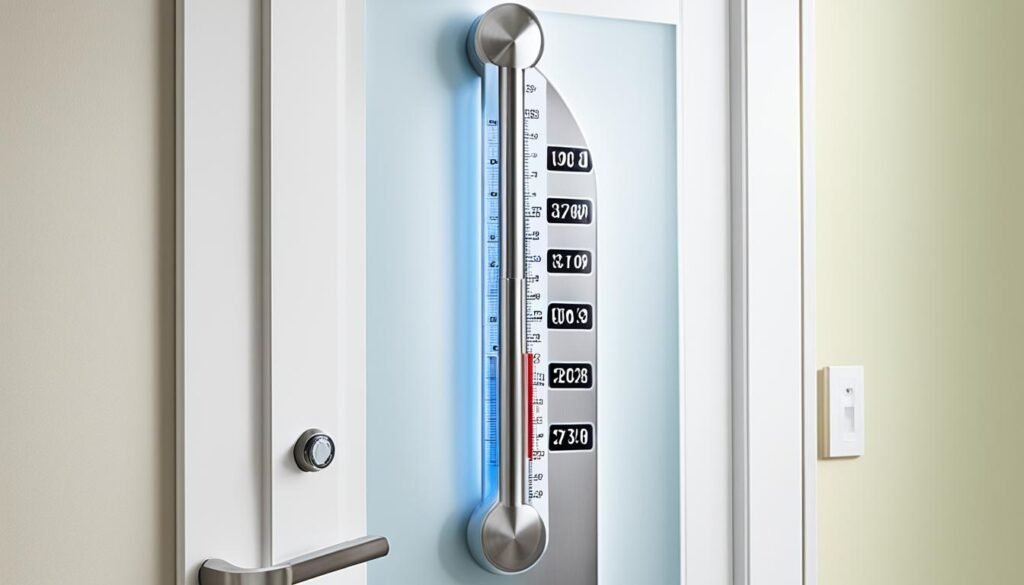
Keeping the right temperature in a kitchen pantry is key to keeping food fresh and safe. First, look at your pantry’s temperature needs space. Is an outside wall making one area warmer? In hot places, this might spoil food quicker.
Assessing Your Pantry Space
Hang a digital or non-digital thermometer, like a ThermoPro, to watch the pantry temp. This helps find places that are too hot or too cold. Then, you can fix them for better storage.
Using Thermometers
It’s important to track how warm or cool your pantry is. Thermometers show if it’s staying the right temperature. They help you figure out if more or less air is needed, or better insulation.
Pantry Door Considerations
The kind of pantry door you pick can change how well it stays cool. Solid doors keep heat in, but doors with slats or windows let the space breathe. The right door choice stops too much heat or moisture, keeping food safe.
Ventilated Pantries: Keeping Moisture Away
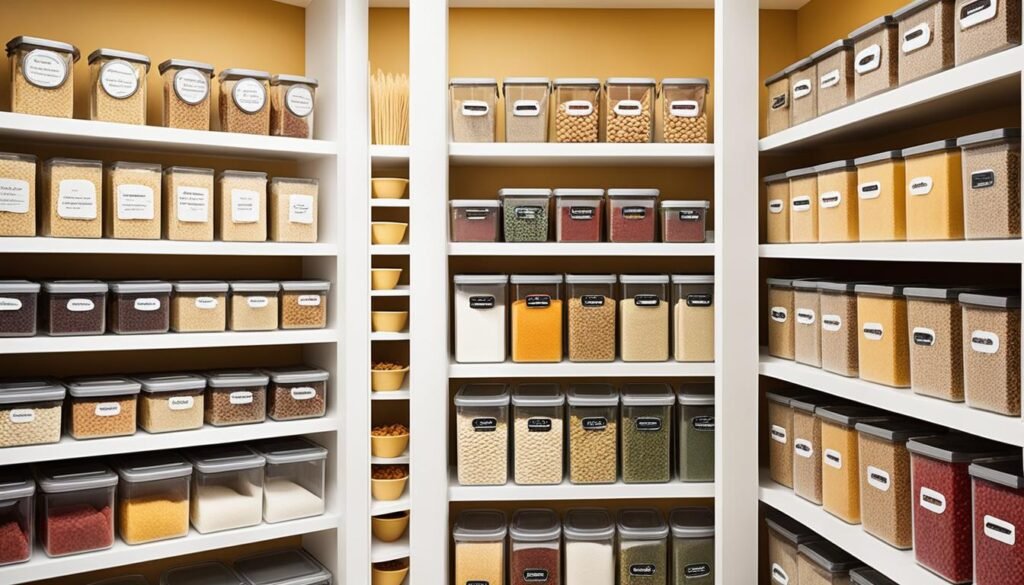
Moisture poses a big issue in kitchen pantries. It can cause rust on cans and other metal containers, making the food inside unsafe. The USDA notes that if a can is rusted, the food is not good to eat. Having good pantry ventilation stops moisture from building up and causing problems.
Rust: A Warning Sign
Finding rust on canned goods or metal containers in the pantry means there’s too much moisture. This rusting can weaken the container and even make the food unsafe. It’s important to deal with moisture and keep your pantry dry and well-ventilated to protect your stored items.
Preventing Moisture Buildup
Good airflow and low humidity are essential for a dry pantry. This keeps your items safe from moisture harm. It becomes even more key in large pantries, walk-in pantries, and corner pantries that can trap humidity without enough air circulation.
Airtight Storage Solutions
Aside from ventilation, using airtight containers made of glass or plastic helps. These keep moisture out and make sure your pantry contents last longer. With airtight storage solutions, humidity won’t spoil your pantry essentials.
Preventing Mold Growth in the kitchen pantry

Mold in a kitchen pantry means it needs better air. Mold is bad for health and food safety. To stop mold, make sure air moves well and lower humidity.
Identifying Mold Issues
Check the pantry often for mold. Deal with it fast to keep your food safe. Mold can spread quickly and spoil your non-perishables.
Improving Air Circulation
Use windows, vents, or fans to move air. This stops moisture from building up. It makes it hard for mold to grow.
Using Dehumidifiers
Dehumidifiers can help a lot, especially in humid times. They keep the air dry, which is bad for mold. It’s a good way to prevent mold.
Natural Ventilation for Pantries
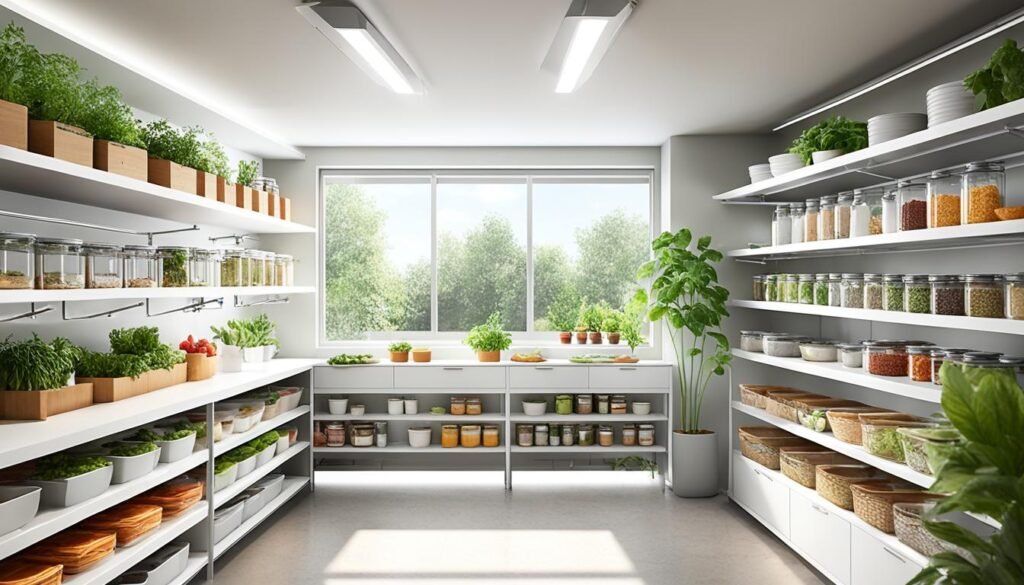
Some kitchen pantries benefit from natural ventilation. It can be a cheap and efficient way to keep the area cool and fresh. Homeowners just need to look at the pantry’s location, the weather, and how humid it gets. This helps in deciding if using windows or vents for ventilation work well. In colder times, some pantries can use fresh outdoor air to stay cool.
Natural ventilation effectiveness changes with each pantry and its setting. It’s crucial to think about what your pantry needs. Things like the layout, door design, and how efficient the pantry is matter a lot. When choosing a ventilation approach, think about how you use and organize your pantry.
Using natural ventilation can make your pantry just right, without spending much on power. This is perfect for small pantries, corner pantries, or walk-in pantries. These spaces might not fit big, advanced ventilation systems. By going natural, homeowners can save money and help the planet.
Optimal Temperature Range for Pantries
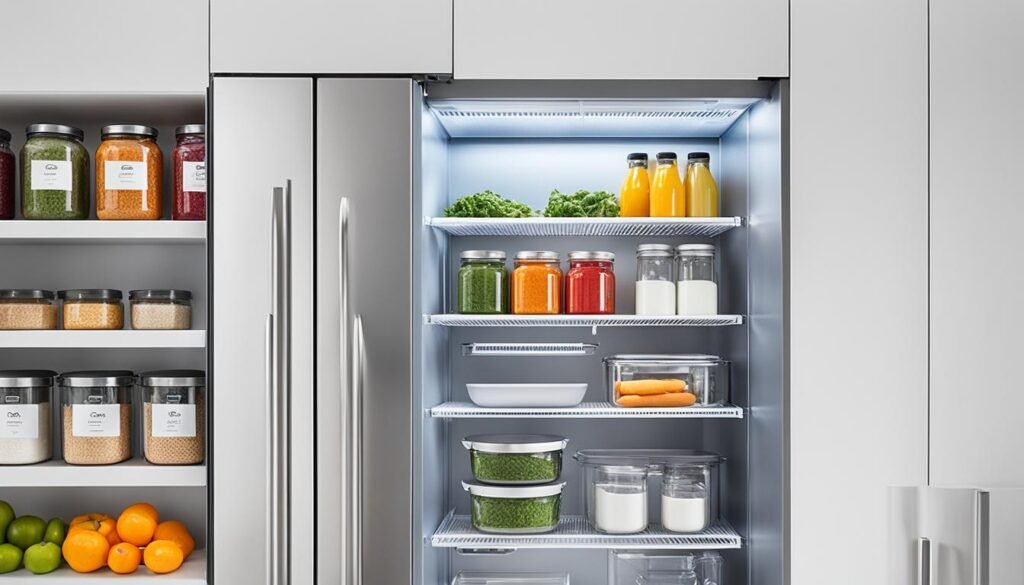
The University of Georgia advises that pantry temperature should be between 50 and 70 degrees Fahrenheit for storage. This range keeps pantry items fresh and safe. If it gets too hot, over 85°F, food can lose nutrients and spoil faster, making you sick.
Recommended Temperatures
For a kitchen pantry to work well, keep it between 50 and 70 degrees Fahrenheit. This is the best range for canned food, dry mixes, and spices. It helps them last longer.
Avoiding Heat Exposure
It’s vital to prevent pantry items from getting too hot, especially over 85°F. High heat can make food lose nutrients, go bad quick, and cause illness. This is a big concern in hot and humid areas or with heat from nearby appliances.
Location and Design Considerations
Think about where your pantry is and if it’s near walls outside. The climate in your area matters too. Good ventilation and temperature controls help keep your pantry at the perfect temperature. This way, your food and supplies stay safe and fresh.
Addressing Bad Odors in Pantries
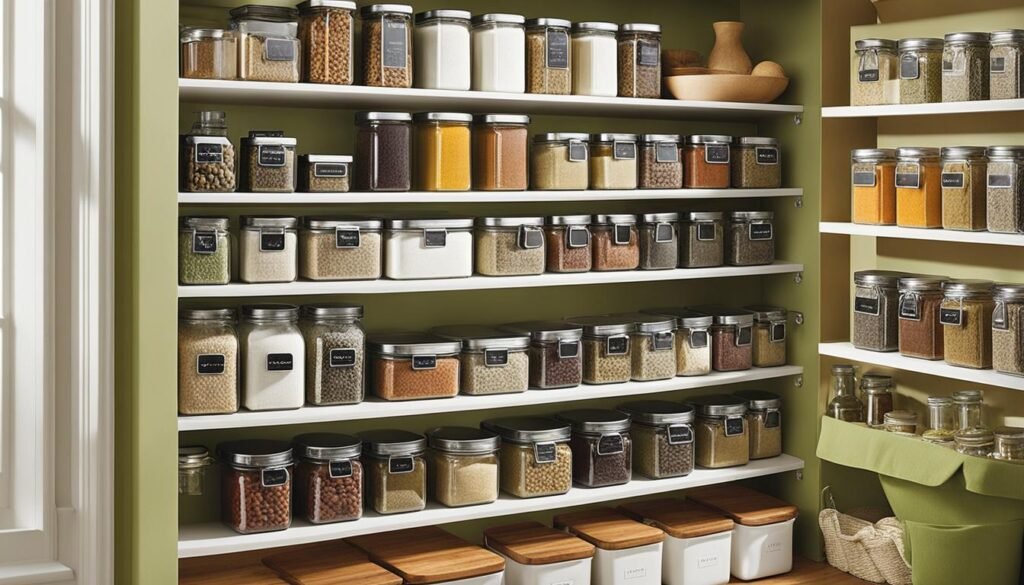
Bad smells in the kitchen pantry are usually because of poor ventilation. This happens when the air doesn’t move well. The smells from things kept there and the heat from nearby appliances get stuck, making the air unpleasant.
Importance of Airflow
It’s vital to let air flow well through the pantry to avoid these smells. Using both passive and active ventilation can help. These systems bring in fresh air, moving the old, stinky air out.
Appliance Considerations
The way we use and place appliances around the pantry affects smells too. It’s important to think about this. With enough venting, the pantry can stay fresh and odor-free.
Also Read : Are You Considering PVC Ceiling Designs For Your Living Room Renovation?
Keeping Pantries Dark
Darkness is key for keeping your pantry items fresh. Light, especially UV rays, can harm your stored foods. This can affect their taste, look, and nutrients. So, keeping your pantry dark really matters.
Photodegradation and Nutrient Loss
Long exposure to light can break down nutrients in your food. Vitamins, minerals, and good stuff in your grains and cereals can go away. To fight this, keep your pantry away from sunlight. Use dark containers for storing your food.
A dark, well-ventilated, and cool pantry keeps your food longer. It stays fresh, tasty, and full of nutrients. This way, your pantry is really making the most of your food storage.
FAQs
Why is proper ventilation important in a kitchen pantry?
A kitchen pantry needs good ventilation to keep items fresh and safe. If a pantry doesn’t have proper ventilation, it could get too damp or moldy. This happens when there’s too much moisture, which isn’t good for the food. Ensuring it’s well-ventilated keeps it fresh longer.
What are the historical significance and benefits of proper ventilation in pantries?
Pantries have been around for ages as food storage spots. They should have ventilation to avoid mold and pests due to dampness. Good air flow controls temperature and keeps food safe. Without it, food might spoil faster or even get moldy.
What are the different types of ventilation systems that can be used in pantries?
There are two main types of ventilation – passive and active. Passive uses natural air flow, like through windows. Active uses machines, such as fans, to move air. Some pantries even have systems to control temperature too.
How can I maintain the right temperature in my pantry?
It’s key to keep the pantry at the right temp for food freshness. Start by understanding your pantry’s layout. A digital thermometer can show you where it’s too hot or cold. Also, the door type affects air flow and temperature.
How can ventilation help prevent moisture-related issues in the pantry?
Moisture in pantries can cause rust, making food unsafe. Good ventilation stops moisture from building up. It moves the air, lowering humidity to keep the pantry dry. Using airtight containers can help too.
How can ventilation help prevent mold growth in the pantry?
Ventilation is vital to keep mold away in the pantry. Mold is unhealthy and damages stored foods. Better air flow and low humidity help. Fans or dehumidifiers can make a big difference.
When is natural ventilation a viable option for pantries?
Natural ventilation works well in some pantries and can be low-cost. It’s based on where your pantry is and the weather. In colder times, cool air might be a good natural way to keep the pantry at the right temp.
What is the recommended temperature range for pantry items?
The University of Georgia says keep your pantry between 50 and 70 degrees. This range is best for food safety and lasting freshness. Hotter temps can spoil food quicker and weaken its nutrients.
How can ventilation help address bad odors in the pantry?
Stale smells in the pantry are usually from poor ventilation. If the air doesn’t move, smells and heat stay. To fix this, make sure the air flows well. Also, be careful where you put appliances to avoid bad odors.
